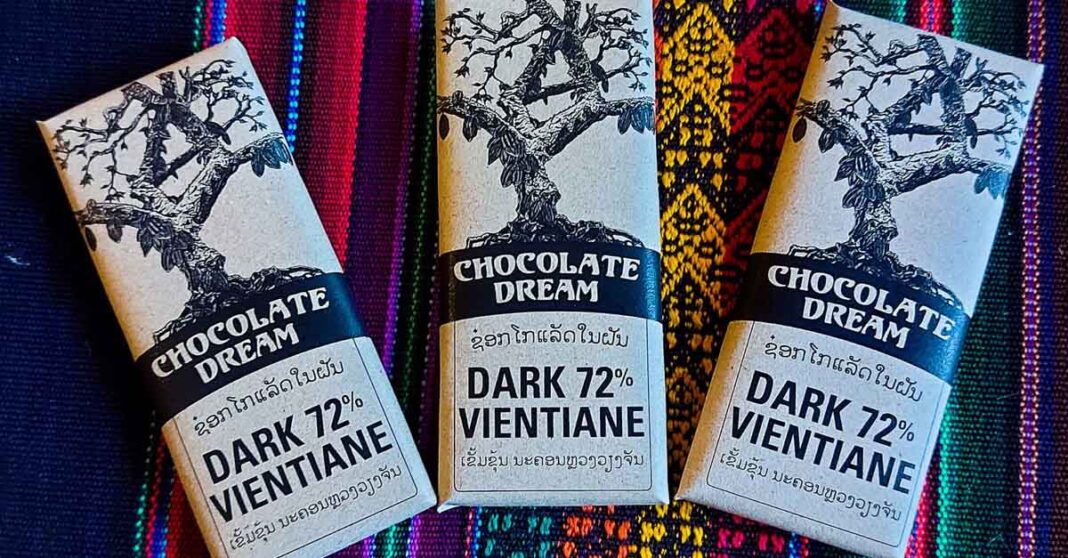In an interview with Bridget Dooley, Mikael Bronkhorst tells the story of how Chocolate Dream by Mikael came to introduce Laos’ first single-origin chocolate bar, a breakthrough for sustainable Lao agriculture and for eco-conscious chocolate lovers alike.
When Belgian chocolate maker Mikael Bronkhorst first began producing chocolate, it was out of personal necessity: “I was living in Laos, and the options for chocolate were terrible. If I wanted good chocolate, I had to pay exorbitant prices for imported bars, and often that foreign chocolate is ruined by the time it makes it to Vientiane.”
Bronkhorst, who was working in eco-tourism at the time, was inspired by his favorite part of Laos: the trees. “I looked up at the forest and I thought, why import expensive chocolate? Couldn’t I make it here? Doesn’t it grow on trees like these, in climates like this one?”
Chocolate Dream began with just Bronkhorst himself and with DIY, home-brew methods. Some of the materials with which chocolate is transformed from bean to bar were readily available as industrial kitchen supplies. Cracking, winnowing, and roasting the beans, however, are more complicated processes, requiring more specialized equipment. Cracking the beans is necessary to remove the husk, while winnowing–the process of using a fan to separate the husks from the seed–separates out the cocoa nibs, which are chocolate in its purest form.
Luckily, the machines to crack, winnow, and roast chocolate beans are quite similar to those used in coffee production: “Really, I’ve piggybacked off the Lao coffee industry, which was already booming by the time I began.” Bronkhorst bought the necessary appliances from already-established Lao coffee producers, including a roaster.

With the production necessities accounted for, Bronkhorst set out to produce the first chocolate bars made in Laos. His first bars, made from Thai beans, were basically inedible, Bronkhorst says. It was only after much experimentation, trial, and error, that Chocolate Dream eventually produced its first quality bar.
Still, Bronkhorst was limited to beans from outside of Laos, sourcing them by necessity from elsewhere in Southeast Asia, particularly Bali. Bronkhorst imported the beans himself, by hand and in small batches, and broke another barrier when it became the first company to use beans from East Timor.
Slowly, experimentation began to build up production capacity, and Chocolate Dream was first available exclusively through retailers and cafes, and now more widely throughout the country, an evolution that has involved educating consumers on the virtues of single-origin chocolate.
“Locally, there hasn’t been much understanding of craft chocolate. What sells as chocolate in Laos is, historically, often just a sugar vehicle. Consumers haven’t understood or cared much about the beans. Now, more Lao consumers are understanding that chocolate, like wine, can be a luxurious experience, and that it doesn’t need to be unhealthy and packed full of sugar.”

In addition to the relative health benefits of what Bronkhorst calls “real chocolate,” a focus on the particularities of cocoa beans benefits the environment, too. Single-origin chocolate highlights the different flavors of different locales, like wine, helping buyers to understand the inextricable link between their food and the land, an important step in improving the wider understanding of agricultural ecology.
Conversely, more Lao consumers are appreciating local products and realizing the harm that imports do to both the local economy and the environment.
As Bronkhorst continued experimenting with bars of varying cocoa-percentages and incorporating local ingredients like pineapple, he was able to grow his business by employing and training Lao employees. Still, he lamented the lack of Lao beans. This wasn’t because cocoa wasn’t growing in Laos–there have, in fact, been cocoa trees in Laos for a long time–but those trees’ cocoa beans have typically been wasted, falling to the ground, never to be fermented, processed, tempered or enjoyed.
Finally, nearly a decade after first producing that first terrible bar from Thai beans, Bronkhorst met a Lao farmer named Houmphan with a hectare of land in Vientiane province that is home to several cocoa trees.
While Bronkhorst had tried to grow cocoa trees of his own, the local environment can make life difficult for cocoa saplings, who must compete with mushroom spores and the industrious termites that feed on them. Houmphan, however, has raised enough chocolate trees to maturity to produce the first all-Lao sourced bars.
Through direct trade and an exclusive farming partnership, the European chocolate maker and Lao farmer have made the first single-origin bar in Laos’ history.
These bars, which contain 72% chocolate, are available exclusively at Lak 40 coffee shop in Vientiane capital, and Bronkhorst says that this small batch of bars are only a small part of his Lao-chocolate vision.
Another recent innovation in Lao chocolate by Chocolate Dream is the inclusion of Mak-bok, Lao wild almonds sourced from that very same forest where Bronkhorst first had his vision of a local Lao chocolate, bringing his journey from forest to bar full circle.
What’s next for Lao chocolate? Chocolate Dream aims, next, at opening its first chocolate shop location, which will serve as a space where Lao chocolate can be shared and enjoyed together, Lao style.



